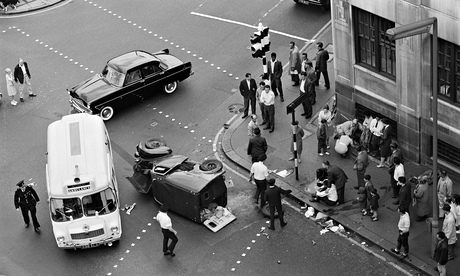
As Colin O’Brien writes in his short introduction to London Life, the view from the top-floor flat he grew up in was his “first window on the world”. In the 1950s and early 1960s, he looked down on the junction of Farringdon Road and Clerkenwell Road and shot images of people passing underneath or congregating on the corner as well as car accidents, religious processions and stragglers wending their way home on a snowy New Year’s Eve past hoardings advertising Guinness, Batchelor’s peas and Sterling cigarettes. Another London, familiar, but now impossibly distant.
If the London that O’Brien chronicled obsessively in black and white seems redolent of the London portrayed by the likes of Roger Mayne or Henry Grant, it is these early aerial shots of Clerkenwell that immediately set him apart both as a precocious observer and someone who instinctively understood that a single neighbourhood could be a kind of microcosm of the bigger human drama of the capital. The Clerkenwell neighbourhood that O’Brien grew up in was solidly working class and nicknamed Little Italy because of the number of Italian immigrants living there, hence the large Roman Catholic processions in honour of Our Lady.
The corner of Clerkenwell Road and Farringdon Road was also a busy junction: silent trolleybuses ran along the road, powered by overhead cables, beside vans, cars, motorbikes and messenger bikes, while trains screeched into Farringdon Station on the adjacent tracks below the railway bridge.
The young O’Brien seems to have been mesmerised by the daily drama of movement and the inevitable chaos that sometimes ensued. He captures the aftermath of one traffic light failure in which a nurse tends to a prone figure while adults and children gawp at an upturned delivery van. Elsewhere, his keen eye takes in the small dramas of London street life: boys playing on derelict sites or scavenging by the Thames.
O’Brien carried a Box Brownie around wherever he went as a boy and remembers being transfixed, aged six, when his Uncle William, “a bit of an outsider”, turned up at Christmas with “a parcel containing some bottles of chemicals, a printing frame and a couple of dishes”. The fascination of the printing process has stayed with him to this day. What he calls his “first real photograph” was taken in 1948: two local boys in short trousers and short-sleeved sweaters leaning against a car parked in Hatton Garden, both looking tough for the camera.
Like many photographers of his generation, O’Brien seems to have pursued his craft purely for his own pleasure, taking photographs that reflected the world as he saw it. Inevitably, he was drawn to Soho and the West End at night, and to football grounds, where the drama on the pitch was reflected in the tension on the faces of the thousands of supporters who packed the terraces and perched precariously on walls and railings. He also catches West Ham and England stars Bobby Moore and Geoff Hurst surrounded by adoring but well-mannered children as they left Fulham’s Craven Cottage on foot.
From the 1950s to the 2000s, O’Brien’s London remains a slightly makeshift place where people do what they can to get by: street markets somehow survive the homogenisation and oddballs still congregate at Speakers’ Corner, but you can sense the capital moving towards the process of gentrification that is currently rendering even Soho an increasingly characterless place. Photography possesses a unique ability to record the everyday and, as the decades pass, to invest the quotidian with a degree of mystery. To this end, London Life is both a celebration of, and an elegy for, another London, recognisable but fast disappearing as property prices threaten the existence of the kind of tightknit communities that O’Brien grew up in. Soon, perhaps, they will only exist in photographs.
London Life is published by Spitalfields Life (£25). Click here to order it for £20

